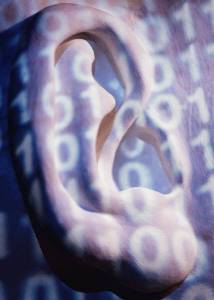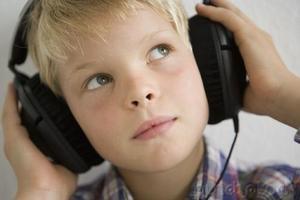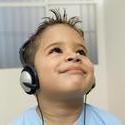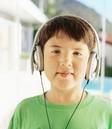Auditory Integration Training and The Brain

Contact Us
Complete
On-line AIT Checklist
OVERVIEW
Auditory
Integration Training is a foundational therapy that trains and coordinates
the efforts of the ear and the audio-recipient structures in the brain.
This approach was developed by Dr. Guy
Berard who was inspired by the work of
Dr.
Alfred Tomatis.
THE HUMAN AUDITORY SYSTEM
This
is a highly specialized system, which is capable of a wide range of functional
plasticity and a great deal of potential to acquire different phonetic
systems. (Prof. Dr. rer. nat. Lutz Jäncke (Project Leader)
at the University of Zurich. In a study using functional MRI, the researchers
at University of Zurich are exploring the degree to which short term influences
can alter the functional neuroanatomy of the auditory system. They
are investigating the activation of the auditory cortex and its adjacent
cortical regions during auditory stimulation. The scientists are
studying the auditory cortices of musicians and non-musicians. They
hypothesize that the human auditory cortex is highly plastic and capable
of adapting to long-term auditory stimulation. This is important
research since with
AIT, our goal is to change how the brain processes sounds. We
use randomized music to present the brain with unpredictable and novel
sounds to process. Our clinical evidence indicates that
AIT has a profound effect on the brain’s rate of
processing sounds.
DESCRIPTION OF AUDITORY INTEGRATION TRAINING
AIT like many other therapies helps to bring
new dimension to the brain functioning. It makes the brain more
efficient. AIT is structured listening
program.
It
takes 10 days to re-train the ears and re-train the brain to function
more efficiently.
AIT, using the Berard
method is a 10 day program designed to improve language comprehension,
clarify hearing and reduce hearing sensitivities.
Each
day of AIT
consists of 2-thirty minute sessions. Clients wear studio quality
headphones and listen to “music” that sounds like its been stirred up
in the blender. That’s called “randomization”.
The
idea is to make the “music” move. The brain learns through movement.
In order to understand the process, think of movement in terms of fluctuating
frequencies and fluctuating volumes of sounds.
AIT influences changes in brain operation by presenting
the ears with fluctuating sounds, which heightens the brain’s attention
to flow along the auditory pathways of the brain.

When
the brain hears these mixed up and novel sounds, it has to switch gears
to a more attentive state.
Over
and over again the brain has to sort and re-assemble the sound segments.
As this is happening inside the brain, many brain structures get practice
in communicating with adjacent brain structures in a new series of circuitry
and by making new connections.
This
information flow is what the brain considers to be movement – in a synaptic
sense. This neuronal activity allows the individual to experience
a heightened awareness of sound processing. During the sessions,
the brain is practicing a series of new levels of attentional states.
FOUR ELEMENTS THAT PERTAIN DIRECTLY TO HUMAN NATURE AND THE BRAIN
As
I have observed individuals throughout the 13 years of practice in the
field of AIT,
four categories of brain functioning have come to mind:
- Neuroplasticity this
is the recognition that change happens in the brain according to experiences
that therapies and learning provide to it. Plasticity isn’t possible
without sufficient attention. Neuroplasticity is the ability of
the brain to shape or mold itself by expansion or contraction of neuronal
processes due to injury, electrical activities or chemical stimulation.
It is dependent upon a structural change of the neuron.
- Attention
This is the brain’s response to the world around it and also its
attempt to encounter the world and its elements.
- Motivation
This is the emotional side of attention. E-motion is
motion outward – it is interactional. It’s the brain attempt to
initiate action or movement. This is a purposeful emotional
state which often leads to interaction with another person or thing.
- And
Movement The means by which the brain learns more about its world.
Movement provides the brain and the individual with an opportunity to
adjust to input. It is one of the outcomes of motivation and emotional
curiosity. Many times movement attempts to find stasis. Think
of movement as information flow along neuronal pathways.

HISTORY
OF AUDITORY
INTEGRATION TRAINING
It was
developed by Dr. Berard
in France nearly 35 years ago. Berard's
method is based upon the work of Alfred Tomatis. The Tomatis
style of Auditory Training is a long, not as intense experience as the
Berard method.
The Berard method was
introduced to the US in the very late 1980’s, it was initially embraced
by the autism support groups through the work of Annabel Stehli, who wrote
“Sound of a Miracle” and later authored a series of anecdotal accounts,
called “Dancing in the Rain”.
Berard AIT was initially developed
for those who had sensitive or painful hearing and then became an alternative
method of helping people with major depression and suicidal tendencies.
THE CURRENT CRITERIA FOR USES OF AUDITORY
INTEGRATION TRAINING
We look
at test results and then compare that to a health and behavior history.
Many people
benefit from AIT,
so diagnosis is not a necessary criterion. AIT has benefited people with:
- closed-head
injury,
- people
with learning disabilities,
- people
on the autism spectrum,
- people
on the ADD spectrum,
- people
with Down Syndrome,
- people
with Rett Syndrome,
- people
with Angelman Syndrome,
- people
with Williams Syndrome,
- people
with episodic or major depression and many people in between.
NEURO-FUNCTIONAL DEFICITS IN AUTISM - AUSTIC SPECTRUM DISORDER (ASD)
There are
4 neuro-functional deficits in autism, according to Lyn Waterhouse at
Trenton State College:
- The
first is a problem with the hippocampus (memory center), too
much cell-packing. It’s inefficient and this means that there’s
too much fragmentation.
- The
second is that the center of the limbic system, the amygdala
is not assigning significance to events as they happen.
- The
third the oxytocin system is faulty and does not allow sufficient
bonding and affiliative behavior.
- The
fourth is too much attention. Over-processing of meaningless
data. There is a problem with the temporal & parietal lobes.
Ratey 326
Remember
the importance of the spectrum factor, these deficits and symptoms will
array themselves along a range of degree of intensity. Therefore,
there is a range of effectiveness of therapies for different people, different
degrees of effectiveness.
HOW LONG DOES AUDITORY INTEGRATION TRAINING
LAST?
For many
people one time through
AIT is sufficient. For people on the autism spectrum or
those with severe forms of sensory integration disorder, they may find
themselves repeating sessions. Most of the people with mood disorder
find one time through to be sufficient; however, Berard
found that those with severe depression, especially with suicidal tendencies,
should go through multiple times.
TESTING AND CANDIDACY FOR AUDITORY INTEGRATION
TRAINING
When we
began our practice in 1991, we used an audiometer to do our intake, midpoint
and exit testing. But when people are very young or when they are non-verbal
or have motor timing problems, this may not be a satisfactory way of finding
out how people hear. So we found out about some equipment that was
manufactured in the UK and was used to test babies. This equipment
is called Otoacoustic Emissions Testing. It sends signals into the
ear canal and then registers the feedback or echo of the cochlea.
The signals have to transit the canal, pass through the ear drum and then
hit the cochlea. That journey is recorded electronically and is
sent to the computer as a graph. So while there really isn’t a direct
comparison to audiometry, it gives a more reliable view of the hearing
profile. It can be made more reliable when behaviors are quiet,
the body is relaxed and ambient noise is reduced.

When we
have a test of the hearing profile in hand, we look to find out which
ear needs the most work. One of the elements we’ve noticed over the years
is that usually there is some asymmetry in hearing potential ear
to ear. So we look at the ear that needs the most work & pick
out the frequencies that are most easily registered. Then we take
that frequency or frequencies out of the music presentation that will
follow over the next 10 days.

This approach is much like
“Constraint-Induced Movement Therapy” devised for stroke patients.
This type of therapy helps to remap the motor strip of the brain.
The therapy is used to restore functions to limbs of stroke patients who
have lost function as much as 45 years before! Schwartz & Begley
192 Edward Taub did landmark work in this area.
The reason I have compared
AIT to
Constraint Induced Movement therapy is because the protocol calls for
restricting the easily heard frequencies and increasing stimulation of
the frequencies registering as troughs on the hearing profile. Furthermore,
added this mix is the randomization of the sounds. The remaining
sounds cut in and out rapidly and unpredictably.
OUTCOMES OF AUDITORY INTEGRATION TRAINING
Some of the outcomes of
AIT are better attention, better listening, more
motivation to engage in social communication, fewer overt symptoms of depression,
better eye contact, better sensory integration, and better balance and
coordination.
No brain really WANTS to
change, so while a person is undergoing
AIT, some adverse reactions may show up in terms
of behaviors and visceral responses. There may be some over-activity,
some fatigue, and increase or decrease in appetite, more irritability,
some nausea, as a result of possible vestibular disturbance.

The unfamiliar,
unpredictable stimulus of randomized “music” leads itself to brain disturbance,
which leads to a reorganization of neurons and re-routing of information
across many structures of the brain. Twenty half hour practice sessions,
give plenty of practice in moving around the new routes and leads to new
attentional levels in the brain. Attention in the brain gains new
vistas.
ROUTING AUDITORY INPUT
The brain
breaks incoming data into tiny bits. It distributes these pieces
to different departments and then reassembles them, collecting other useful
pieces of information along the way that relate to our past experiences
and even what we WANT to hear.

https://www.umanitoba.ca/faculties/medicine/anatomy/EAROBJEC.htm
The sounds
signals are actually registered as pressure changes, like vibrations,
that hit the ear drum & move the little bones in the ear. They
travel further into the ear to the cochlea – shaped like a seashell –
a spiral container filled with hair cells that bend as they are vibrated.
Each of the 15,000 hair cells responds to particular frequencies at particular
loudness. Ratey 91
- The
hair cell motion is converted into electrical signals that fire neurons.
- Each
hair cell is sensitive to a limited frequency range
Our
brains actually SHAPE what we hear.
There
are more neural networks extending FROM the brain TO the ears than are
coming from the ears to the brain. Ratey 93

https://www.conradsimon.org/AuditorySystem.shtml
Layer
upon layer of sound units pile up and beg to be registered by a whole
array of brain departments. The brain develops “models” of what
it expects to hear – phonemes, words, or music.
Those who
are dyslexic or who have a condition called Central Auditory Processing
Disorder, CAPD, must be continually surprised at what they hear.
Their phonemic models continually break down. This leads to a sort
of communication traffic jam. Ratey 93
THE EAR
First the
ear processes the sounds. Then the information is broken down &
channeled to the brainstem, through the auditory nerve. This nerve
has 25,000 nerve fibers – which are not many compared to the nerve bundles
for vision and touch. The nerves are always fired up, ready to take
information to the right spots in the brain.

https://www.conradsimon.org/AuditorySystem.shtml
THE BRAINSTEM
The brainstem
sorts its pieces of information by tone and timbre or quality of the piece
of sound. The brainstem preserves the sound and starts to distinguish
the sets of sounds as phonemes, that don’t carry any meaning in themselves.
Ratey 94 The medulla examines the vibrations for spatial characteristics.
Ratey 94 We maintain mental maps in our cortex to estimate WHERE
the sound comes from – per research that has come out from Michael Graziano
at Princeton University. Ratey 113
OLIVARY STUDY – HEARING NEAR & FAR
The brainstem
sends the sound vibrations to the superior olivary to figure out that
louder sounds are closer. Here is where it is interesting to bring
in information from Scientific American Feb 2000 article on autism by
Patricia Rodier. She notes that in autopsy studies that people with
autism have a “disappeared” superior olivary!!!! She notes that
there are other physical characteristics and brain measurement anolomalies
with people with autism.

The olivaries
send messages to the midbrain and this coordinates the body’s reflexes
and reactions. The superior colliculus in the midbrain is crucial
for integrating sensory information from the sensory information systems.
It tries to bring about a unified response to experiences.
Ratey 94 The Superior Olivary has a lot to do with timing.
It interprets information from both ears.
THE JOURNEY CONTINUES
From the
superior colliculus, the auditory impulses travel to the thalamus and
then to the primary auditory cortex in the temporal lobe. This links
it to the secondary auditory cortex and that structure connects to other
parts of the brain which coordinate hearing with memories and awareness.
As the signals travel to the medial geniculate bodies (in the thalamus),
the signal is divided between 2 types of cells: the parvocellular
and the magnocellular cells. The magnocellular process the rapidly
incoming sounds & send them to the auditory cortex.

https://pages.unibas.ch/dmr/mr_physik/research/fMRI/auditory/main.htm
AUDITORY
CORTEX
By the
time the sound signals arrive in the cortex, the columns of neurons there
are sensitive to specific differences in sound frequencies and changes
in frequencies and cause different columns to fire. Then the cortex
must do a comparison between the patterns generated by the columns of
neurons with the stored patterns with which it’s already familiar.
Ratey 94/95
LONG TRIP
As you
can see there’s a very complicated route that these signals must travel.
Auditory impulses travel across a large neural landscape. The left
and the right sides of the brain must work together to discriminate complex
sounds. The right side examines the sounds for harmonies and relationships
between close sounds. The left side compares auditory information
with the language centers. Ratey 95/96

BROCA’S
AREA
Broca’s
Area is located in the left frontal lobe near the primary motor cortex.
Paula Tallal (FastForWord fame) has found that fast processing of speech
takes place in Broca’s area of the Left Hemisphere. Broca’s area
is thought of as the controller of the motor cortex (controller of voice
box and tongue). Apparently speech has a great deal to do with the
movement regions of the brain. Ratey 97

In the
1990’s, researcher Michael Merzenich at the University of California (San
Francisco) found in animal research that auditory inputs have the power
to change the brain. By altering sound input, they found changes
happening in the auditory cortices of monkeys’ brains – this factor changed
the rate at which the brain processes sounds.
When Merzenich
and Tallal put their research together, they discovered that children
with specific language impairment construct their auditory cortex from
faulty inputs. They found these children take as long as 1/3 to
1/5 of a second to decode mini sound segments, this is as long as it takes
neruo-typs to process SYLLABLES. One factor in the specific language
impairments were the number & intensity of ear infections. Schwartz
& Begley
AIT, like many other therapies helps to bring new
dimension to the brain and how the brain operates. I like to think
that it makes the brain more efficient.
CHANGES IN AUDITION
In 1999
there was research performed by Rainer Klinke at the Physiologisches Institute
of Frankfurt, Germany. He tested the effects of cochlear implants
on a group of 3 to 4 month old kittens who had been born deaf. Brain
imaging showed that the unstimulated auditory nervous system in the deaf
kitties had not developed like normal cats. After the implants,
the kitties began to respond to sounds in the same way cats born with
normal hearing did.
Not surprisingly,
their auditory ciritces
change too. Within a short time the size of the region of the auditory
cortex that responded to sound had increased. The strength of the
electrical signals in the auditory cortex rose and measures of information
processing in the cortex increased as well. Schwartz & Begley
192
When scientists
remove the cochlea of lab animals in one ear soon after birth. The
number and size of auditory neurons in the brainstem are reduced.
But this effect can be reversed again by providing sensory input.
For instance, with congenitally deaf children given cochlear implants
(which bypass the damaged sensory hair cells of the inner ear) and carry
acoustic signals directly to the cortex of the brain, the sudden onset
of sensory – in this case auditory – input leads to nearly perfect speaking
and hearing as well as individuals with normal language development.
Schwartz & Begley 125
THE BRAIN AND SOME VALUABLE BRAIN STATISTICS
Here
are some interesting statistics about the brain:
- The
brain is the greediest organ of the body.
- It burns
oxygen & glucose at 10 times the rate of all other body tissues
– at rest!
- The
brain is only 2.5% of the total body weight, but is responsible for
20% of the energy consumed when the body is at rest. Greenfield
27
- The
brains of children between the ages of 3 and 10 consume two times as
much of the blood nutrient glucose as those of adults. Ratey 35
- The
brains of children are less efficient and therefore need more fuel.
- Auditory
neurons appear in the first 3 weeks after conception.
- Auditory
centers in the brainstem emerge by 13 weeks of gestation.

The brain
is vital for processing and coordinating information that floods through
the senses. The outputs of the brain are expressed as movements
(muscular and neural). Greenfield 33 All human communication
relies on movement whether its body language, how the lips, tongue and
mouth move when speaking or in physical gestures, (like a hug).
Neurons
actually anticipate signals – that is – they are primed to expect the
same old kind of signal. But when they get a new intensity of signal
or a new nuance of signal, they perceive the input as new & quite
disturbing. Greenfield 33 This disturbance is good, since
it leads to reorganization. Ratey 56
- A baby’s
brain contains something on the order of 100 billion nerve cells.
- Each
neuron makes an average of 2,500 connections or synapses.
- The
connectivity peak may be 15,000 synapses by the time the child is 2
or 3 & then the system goes through a period of “pruning”.
- The
synapses that stay are more efficient and carry traffic more reliably.
- The
motto of neurons is survival of the busiest.
The adult brain boasts about 100 trillion synapses, some estimates go
as high as 1,000 trillion. Schwartz & Begley 117

MOVEMENT AND THE BRAIN
Movement
is a very important factor in brain development. It’s important
for most brain functions, like memory, emotion, language and learning,
cognition and to behavior. Ratey 148 You will hear about the
cerebellum anytime you hear about movement and the brain. The cerebellum
coordinates physical movement, as well as the movement of thoughts.
The brain
circuits that control, sequence and time mental acts are the same circuits
that are used to control or order, sequence & time physical acts.
Ratey 148/149 Motor activity takes place in 3 stages:
- We analyze
the incoming data (either external or internal)
- We formulate
& monitor a response plan – this is the stage that involves
thought-processing. It is here at this sequencing stage that involves
organizing the serial order of information & integrating this information
with the previously learned data.
- We execute
the plan
We can
surmise that exercise can produce chemical changes that give us stronger,
healthier & happier brains. We must not forget to view PLAY
as a motor activity – it helps learning & social relationships develop. PLAY
is an activity that gives children a sense of mastery & is rewarding.
Play as a motor activity prepares us for later adult social interactions.
Ratey 176/177
MOTION AND MOVEMENT OF INFORMATION
The entire
front half of the brain is devoted to organizing action – physical &
mental. The frontal cortex is the most interconnected part of the
brain. Ratey 148 The primary motor cortex & the premotor
cortex are located here. Ratey 156 This is where our “self-awareness”
lies. It is driven by motor neurons. Another actor is the
cerebellum as mentioned before. The cerebellum heavily influences
the cortex. Ratey 151

The sensory
cortex located just behind the primary motor area gathers additional data
about our thoughts, past experiences, emotions and stored memories, which
gives our movements & actions extra meaning, and complexity.
Ratey 157
Motor function
happens under the influence of attention & emotion. Our brains
constantly use attention and emotion to determine what is important &
what is not. This ability determines whether we survive. The
feedback loop is extra tight between the motor system and the attentional
and emotional circuits. Ratey 171
MUSIC EQUATED WITH MOTION
Music makes
both sides of the brain work interdependently. The left side is
better at targeting the succession of sounds – the rhythm. The right
side works on elements of timbre – sound quality.
Henri Platel
(from the University of Caen, France) used PET scans to study non-musical
men as they listened to classical music and the random sequences of musical
notes. He found that Broca’s area was activated then his subjects
listened to classical (well-known) pieces of music. Ratey 97
- The
brain is an organ that breaks sensory information apart and reassembles
it to form the final “perception”. There is not single “attention
center.” There are multiple distribution systems.
- The
prefrontal cortex occupies itself with task related memory and planning.
- The
parietal cortex involved itself with bodily and environmental awareness
- The
anterior cingulate is concerned with motivation.
- The
cerebellum and the basal ganglia center their efforts with habit formation
and coordination of movement. Schwartz & Begley 331
BRAIN SYSTEMS
It’s important
to think of the brain as a series of systems, overlaid and inter-related.
The cerebellum plays an important role in motor memory. Ratey 204
Eric Courschene is a well known researcher whose work in autism autopsy
studies has shown that there is a reduction and disarray in the number
of Purkinje neurons in the cerebellums of people with autism. These
are filtering neurons; they have much to do with the information that
leaves the cerebellum to make its way to the frontal cortex. Ratey
307
This deficit
in the function of the cerebellum has a great effect on how the world
may be perceived by a person with autism. The world may look very
chaotic and incoherent. The cerebellum has a big job of coordinating
the incoming visual, auditory and somatosensory information. Depending
on how the information is filtered on its outgoing trip to the higher
parts of the brain, the ability to shift attention from one sensory issue
to the next is in peril.
The cerebellum
is recently been implicated in how one functions socially. It is
an important area of the brain as the cerebellum is a star player in cognition.
The cerebellum is a major association center a major switchboard in regulating
attentional states. Ratey 305
The brain
relies upon a sensitive system of feedback loops. For instance,
motor memory is achieved with a very sophisticated feedback system. Ratey
179 In order for effective motor memories to operate the frontal
cortex plans & organizes the events, while depending upon the basal
ganglia & hippocampus to store memories in long-term storage banks.
Ratey 205/206 The frontal lobe is termed the brain’s executive function.
AIT OUTCOMES AND BRAIN NEUROPLASTICITY:
NEUROPLASTICITY & THE CHANGING LANDSCAPE OF ATTENTION IN THE BRAIN
Sensory input in itself it not responsible for brain change. The
most important factor is the attentional state. Research by Michael
Merzenich in 1993 indicates that passive stimulation doesn’t do the job
of changing the brain circuits. When monkeys listened to specific
frequencies – auditory cortex landscape enlarged, but when the monkeys
were distracted, they lost circuitry strength & landscape.
Schwartz & Begley
For people
with autism, information is unfiltered, poorly routed and they are unable
to “pay attention”. The sensory information speeds along too fast
for them to catch and process. Ratey 78 Sensory integration
must be intact in order for the perception of the world to make sense.
Ratey 82 This is the ability of the brain to make new connections
and assume new roles. Plasticity follows an increase or decrease
in sensory input.
Neuroplasticity
is concerned with taking over unused regions of the brain or remodeling
the whole landscape. Schwartz & Begley The
simple act of paying attention can make physical changes within the brain.
Attention is influenced by the limbic system & importantly the amygdala.
Ratey 121 Experience molds the brain, but only a brain that pays
attention. Neuroplasticity or cortical reorganization is use induced.
Schwartz & Begley Cells that fire together, wire together, strengthening
the synaptic routings. This means that the cells must “practice
together” over and over again. Schwartz & Begley 107
MOTIVATION AND EMOTION
Emotion
is movement outward. It conveys our important internal states and
needs. Ratey 227/228 The limbic system is an incredibly interconnect
circuitry which is the launching point for emotions. The upper cortex
and the limbic system are in continuous feedback loop status. Ratey
228
- Motivation
is a process the ties emotion & action.
- Motivation
is the director of emotions.
- Motivation
is the pressure to act. Ratey 247
AUDITORY INTEGRATION TRAINING STUDIES
There
are some very important studies
that show how AIT
works.
- PET
SCAN STUDY
The first significant one is
a PET scan study by High fill & Cimorelli, from North Carolina.
This is single-subject study using Positron Emissions Testing to show
the changes in the brain pre-AIT
& Post-AIT. The PET scans
show how much energy the brains use. The PET graphs show
more efficient use of energy in more areas of the brain.
This was an 8 year old boy with mental retardation and autism.
The results showed a “normalization” of brain wave activity including
a decrease in hypermetabolism of the frontal lobe and an increase in
activity in the occipital lobe.
- OCCUPATIONAL
THERAPISTS’ STUDY
The second study mentioned in the slide
is that of Sheila Frick and Nancy Lawton-Shirley, both occupational
therapists, from Hudson, Wisconsin. They felt that changes brought
about by AIT
facilitated improvement in movement perception with
people who experienced gravitational insecurity prior to training.
They also noticed positive changes in overall arousal, organization
and social-emotional responses. They used a case-study
approach with two sets of identical twins.
- NEW
ZEALAND STUDY
The third study is also a case study conducted
over a 6 month period of time in New Zealand. This study involved
46 participants or varying diagnostic groupings. It was conducted
under the sponsorship of the Crippled Children Services in Tauranga.
The results of these case studies can be found on pages 95-111 of the
Resources Guide 2005.
THERE ARE 28 CLINICAL RESEARCH STUDIES ON AIT
The 28
studies posted on the Autism Research International website by Drs.
Stephen Edelson and Bernard Rimland. This analysis distinguishes
the diagnostic groups, whether findings were in favor of
AIT, or whether the study
results were controversial and ambiguous and then whether the results
were unclear and whether there were no effects. None of the studies
showed no effects. Three studies
indicated the studies had
unclear results and two studies
showed controversial/ambiguous or contradictory results. Of the
28 studies, 23 showed positive
results for AIT.
BIBLIOGRAPHY
- A
User’s Guide to the Brain,
Perception, Attention & the Four Theatres of the Brain, by John
J. Ratey, MD
- The
Mind and the Brain, Neuroplasticity & the Power of Mental Force,
by Jeffrey M. Schwartz, MD & Sharon Begley, published by Regan Books
- The
Secret Life of the Brain by Richard Restak, MD published by
Joseph Henry Press
- The
Human Brain, A Guided Tour, by Susan A. Greenfield, Published
by Basic Books
- Mapping
the Mind by Rita Carter, Published by University of California
Press
- The
Early Origins of Autism New research into the causes of
this baffling disorder is focusing on genes that control the development
of the brain by Patricia M. Rodier Scientific American, Feb 2000
Reprinted by permission from Marcialyn (Marcy) McCarthy, M.A.
Michael R. McCarthy is a developmental
psychologist and his wife Marcy McCarthy has a Masters degree in Special
Education with an emphasis in early childhood.
Return to top
| 


















